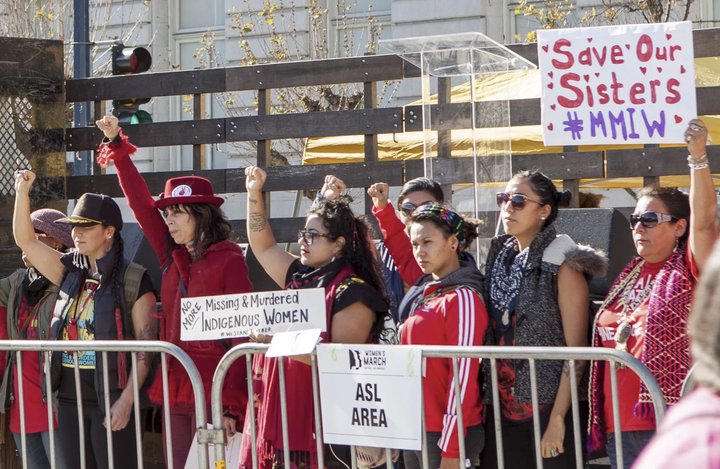
2018 Women’s March San Francisco attendees raise fists and hold signs in support of missing and murdered indigenous women. Photo by Pax Ahimsa Gethen via Creative Commons
For generations, order and cleanliness had been Christina Lastra’s family’s way of fighting off poverty. But the day in July 1991 when her mother’s mysterious death was ruled an accident marked the end of the orderly life Lastra had been leading in Humboldt County.
“We didn’t get peace. No one ever even thought of looking further into the death of a Native woman, of my mom,” said Lastra, who identifies as Indigenous and Chicana. “Until now.”
A new report by the Sovereign Bodies Institute, a data-driven nonprofit based in Humboldt, details for the first time the lack of scrutiny and data surrounding the cases of 105 missing and murdered Indigenous women and girls across northern California, from the Bay Area to the Oregon border. Using state and federal data, other research, police reports and community-based information, the institute found more than 2,300 cases in the United States.
Of the California cases classified as murders, law enforcement solved 9 percent, researchers found. The statewide clearance rate is more than 60 percent in the past decade, according to the state Department of Justice, meaning that murders of Indigenous women in northern California were about seven times less likely to be solved than homicides involving all other victims.
“Women after women, disappearing,” said Annita Lucchesi, the executive director of SBI and a Cheyenne descendant. “It creates a sense of hopelessness. It makes it feel like this is a world that we can’t live in anymore.”
The cases documented in the institute’s report span over a century, but 72 percent occurred after 2000, and problems collecting data on crimes against Native American women suggest the actual number is much higher — around 1,700 statewide since 1900, according to researchers who extrapolated from existing data.
California is home to 700,000 Indigenous people, the largest Native American population in the country, but there is no reliable data on missing Native women in the state, according to Lucchesi, who said more than half of the cases in the state were not in official missing persons databases. When records were available, the report found, Native women were often misclassified as white, or their deaths were labeled accidental even when family and friends thought otherwise. Much about the cases remains unknown because of difficulties in data collection and a “chronic and pervasive failure to investigate,” the report said.
Almost a year after she learned her mother, Alicia Lara, had died in a car accident, Lastra said she reached out to the county coroner. She had heard that someone from Weitchpec, where her mother was found, had seen her shortly before her death, badly beaten up. That’s when she learned that her mother’s body had been found in the passenger seat of her car.
“If they’d just ask around, I think people in Weitchpec knew that she didn’t have an accident,” Lastra said. “But she wasn’t important enough to open an investigation.”
Humboldt County Sheriff William Honsal, who has headed the department since 2017, said the case report for Lastra’s mother didn’t strike him as particularly suspicious. But he said he did have trouble understanding how Lara had gotten in the passenger seat. “It’s hard to see how this could’ve happened,” Honsal said. No investigation was opened.
“There may have been things that have happened in the past, things that didn’t go well, where communication didn’t happen,” Honsal said. “We’re learning from past mistakes, trying not to repeat that in the future.”
Lastra’s perception that local police didn’t put enough effort into her mother’s case isn’t unique. Lucchesi said the report found deep mistrust toward law enforcement among Indigenous women.
Policing in tribal areas is tricky. Jurisdiction is shared with the tribes, who have police forces with limited powers, and communication between county and tribal departments has historically been limited, something many tribes would like to remedy, according to Abby Abinanti, chief judge for the Yurok Tribal Court and a co-author of the report.
The lack of resources experienced by some northern California police departments, combined with the sheer size of territory officers have to patrol, adds to the difficulty of investigating cases, the report found, a problem echoed by sheriffs across the region. High poverty rates, which according to the 2018 American Community Survey bordered 40 percent for the Yurok and Hoopa Tribes, two of the largest tribes in the state, also make it hard for victims to advocate for their family members and for tribes to build efficient police forces.
Last fall, in recognition of the crisis of missing and murdered Indigenous women and girls, the Justice Department launched Operation Lady Justice, to combat violence and human trafficking of Native Americans. State Assemblyman James Ramos, a Democrat from San Bernardino County, is pushing for a bill that would establish a task force to study the disappearances and provide financial assistance to law enforcement and tribal governments.
In the meantime, Indigenous women are leading the effort to investigate. “I want to find those bodies,” said Abinanti, who was the first Native American woman to pass the state bar. “And then, prosecution is at the bottom of the list, but it’s on the list.”
But the main priority remains for victims’ families to find closure.
“We’re treated like we don’t count, but you know what?” Lastra said. “My mother counted and I am her legacy and I count. This report makes me feel like she is finally being honored.”
This article is part of The California Divide, a collaboration among newsrooms examining income inequity and economic survival in California.
###
CALmatters.org is a nonprofit, nonpartisan media venture explaining California policies and politics.
CLICK TO MANAGE